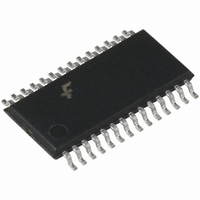FAN5094MTCX Fairchild Semiconductor, FAN5094MTCX Datasheet - Page 18

FAN5094MTCX
Manufacturer Part Number
FAN5094MTCX
Description
IC CTRLR DC/DC SYNC BUCK 28TSSOP
Manufacturer
Fairchild Semiconductor
Datasheet
1.FAN5094MTCX.pdf
(22 pages)
Specifications of FAN5094MTCX
Applications
Controller, Intel Pentium® IV
Voltage - Input
12V
Number Of Outputs
1
Voltage - Output
1.1 ~ 1.85 V
Operating Temperature
0°C ~ 70°C
Mounting Type
Surface Mount
Package / Case
28-TSSOP
Output Voltage
1.85 V
Output Current
60 A
Mounting Style
SMD/SMT
Maximum Operating Temperature
+ 70 C
Minimum Operating Temperature
0 C
Lead Free Status / RoHS Status
Lead free / RoHS Compliant
Other names
FAN5094MTCXTR
FAN5094MTCX_NL
FAN5094MTCX_NLTR
FAN5094MTCX_NLTR
FAN5094MTCX_NL
FAN5094MTCX_NLTR
FAN5094MTCX_NLTR
FAN5094
For the high-side MOSFET, the gate charge is as important
as the on-resistance, especially with a 12V input and with
higher switching frequencies. This is because the speed of
the transition greatly affects the power dissipation. It may be
a good trade-off to select a MOSFET with a somewhat
higher R
available. For high current applications, it may be necessary
to use two MOSFETs in parallel for the high-side for each
phase.
At the FAN5094’s highest operating frequencies, it may be
necessary to limit the total gate charge of both the high-side
and low-side MOSFETs together, to avert excess power dis-
sipation in the IC.
For details and a spreadsheet on MOSFET selection, refer to
Applications Bulletin AB-8.
Gate Resistors
Use of a gate resistor on every MOSFET is mandatory. The
gate resistor prevents high-frequency oscillations caused by
the trace inductance ringing with the MOSFET gate
capacitance. The gate resistors should be located physically
as close to the MOSFET gate as possible.
The gate resistor also limits the power dissipation inside the
IC, which could otherwise be a limiting factor on the switch-
ing frequency. It may thus carry significant power, especially
at higher frequencies. As an example, consider the gate
resistors used for the low-side MOSFETs (Q2 and Q4) in
Figure 1. The FDB7045L has a maximum gate charge of
70nC at 5V, and an input capacitance of 5.4nF. The total
energy used in powering the gate during one cycle is the
energy needed to get it up to 5V, plus the energy to get it up
to 12V:
This power is dissipated every cycle, and is divided between
the internal resistance of the FAN5094 gate driver and the
gate resistor. Thus,
and each gate resistor thus requires a 1/4W resistor to ensure
worst case power dissipation.
The same calculation may be performed for the high-side
MOSFETs, bearing in mind that their gate voltage swings
only the charge pump voltage of 5V.
18
P
E
Rgate
=
=
QV
482nJ
DS,on
=
+
1
-- - C
2
------------------------------------------------ -
-------------------------------- -
4.7
R
, if by so doing a much smaller gate charge is
gate
E f R
4.7
V 2
+
+
1.0
R
=
internal
gate
70nC 5V
=
19mW
=
+ 5.4nF
482nJ 300KHz
1
-- -
2
12V 5V
–
2
Inductor Selection
Choosing the value of the inductor is a tradeoff between
allowable ripple voltage and required transient response. A
smaller inductor produces greater ripple while producing
better transient response. In any case, the minimum induc-
tance is determined by the allowable ripple. The first order
equation (close approximation) for minimum inductance for
a two-phase converter is:
where:
Vin = Input Power Supply
Vout = Output Voltage
f = DC/DC converter switching frequency
ESR = Equivalent series resistance of all output capacitors in
parallel
Vripple = Maximum peak to peak output ripple voltage
budget.
One other limitation on the minimum size of the inductor is
caused by the current feedback loop stability criterion. The
inductor must be greater than:
where L is the inductance in Henries, R
resistance of one phase’s low-side MOSFET, R
value of the droop resistor in Ohms, V
and V
mula will not present any limitation on the selection of the
inductor value.
A typical value for the inductor is 1.3 H at an oscillator
frequency of 1.2MHz (300KHz each phase) and 220nH at an
oscillator frequency of 4MHz (1MHz each phase). For other
frequencies, use the interpolating formula
Schottky Diode Selection
The application circuits of Figures 1-2 show a Schottky
diode, D1 (D2 respectively), one in each phase. They are
used as free-wheeling diodes to ensure that the body-diodes
in the low-side MOSFETs do not conduct when the upper
MOSFET is turning off and the lower MOSFETs are turning
on. It is undesirable for this diode to conduct because its high
forward voltage drop and long reverse recovery time
degrades efficiency, and so the Schottky provides a shunt
path for the current. Since this time duration is extremely
short, being minimized by the adaptive gate delay, the selec-
tion criterion for the diode is that the forward voltage of the
Schottky at the output current should be less than the forward
L 3 10
L
min
o
is the output voltage. For most applications, this for-
=
V
---------------------------------- -
–
10
in
L nH
–
R
2 V
f
DS on
out
1.86 10
-------------------------- - 240
f KHz
R
V
---------- -
V
Droop
out
in
PRODUCT SPECIFICATION
6
-----------------
V
–
in
ESR
ripple
DS,on
is either 5V or 12V,
V
REV. 1.0.2 5/13/02
in
–
is the on-state
2V
Droop
o
is the











